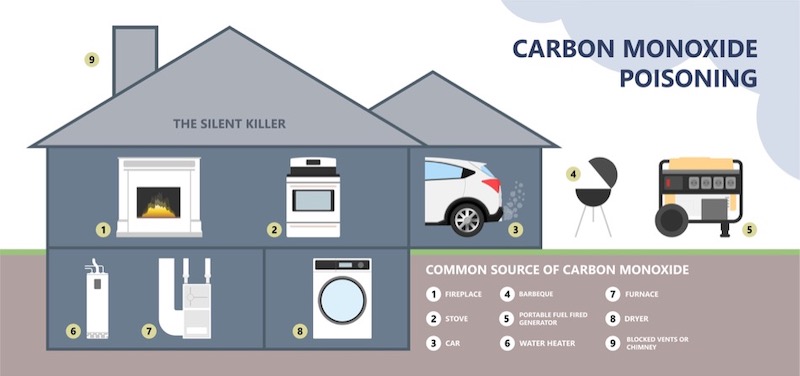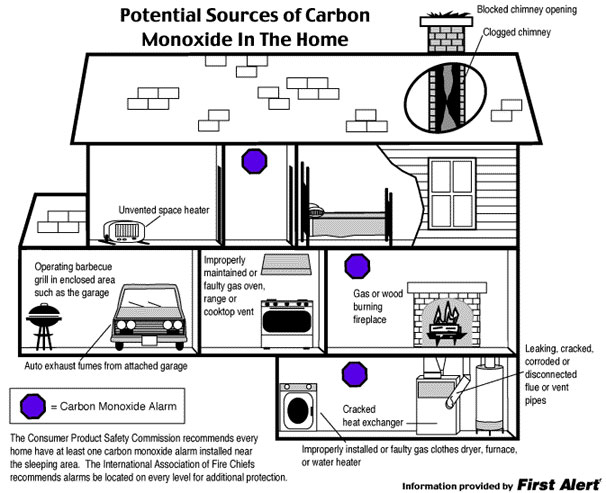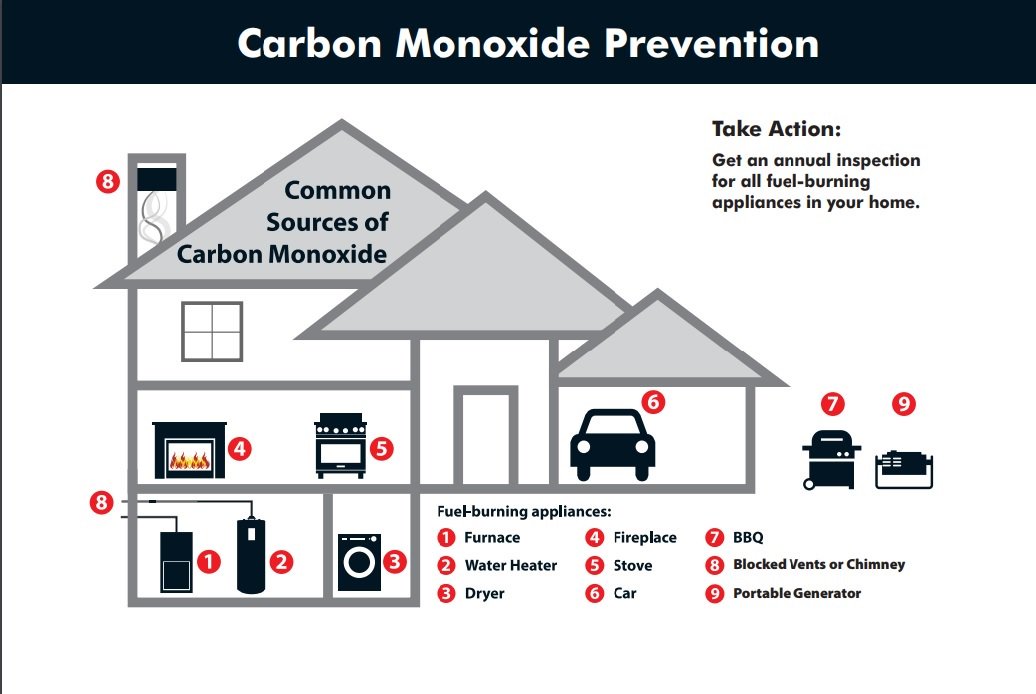How Do Carbon Monoxide Get In Your House

The Silent Threat: Understanding How Carbon Monoxide Enters Your Home
Carbon monoxide (CO) is an odorless, colorless, and tasteless gas, making it incredibly dangerous. Often called the "silent killer," CO can quickly incapacitate and even kill victims before they are aware of the problem. Understanding how carbon monoxide gets into your home is crucial for maintaining a safe and healthy living environment, especially when considering new or upgraded HVAC systems.
Common Sources of Carbon Monoxide
Carbon monoxide is produced by the incomplete combustion of fuels. This means that any appliance that burns fuel, such as natural gas, propane, oil, or wood, can potentially produce CO. The following are the most common culprits:
- Furnaces: A faulty or poorly maintained furnace is a primary source of CO. Cracks in the heat exchanger, blocked vents, or improper combustion can lead to CO leaking into your home. The AFUE (Annual Fuel Utilization Efficiency) rating of your furnace is not directly related to CO production, but regular maintenance and inspection can prevent CO leaks.
- Water Heaters: Gas-powered water heaters can also produce CO if not properly vented or if the burner is malfunctioning.
- Fireplaces (Wood and Gas): Wood-burning fireplaces can release CO into the home if the chimney is blocked or if there isn't sufficient airflow. Gas fireplaces also require proper venting and maintenance.
- Gas Stoves and Ovens: While primarily designed for cooking, gas stoves and ovens can emit CO, especially if the burners are not burning correctly (indicated by a yellow or orange flame instead of blue). Proper ventilation, such as a range hood, is essential.
- Portable Generators: Never, ever operate a portable generator inside your home, garage, or any enclosed space. Generators produce significant amounts of CO and can quickly reach lethal levels.
- Cars and Trucks: Running a car or truck in an attached garage, even with the garage door open, can allow CO to seep into your home.
- Charcoal Grills: Similar to generators, charcoal grills should only be used outdoors, away from windows and doors.
How Carbon Monoxide Enters Your Living Space
Even with functioning appliances, CO can still enter your home due to several factors:
- Improper Venting: This is the most common reason for CO buildup. Furnaces, water heaters, and fireplaces rely on vents and chimneys to exhaust CO safely outside. Blocked, damaged, or improperly installed vents can cause CO to back up into the home.
- Cracked Heat Exchanger: In furnaces, the heat exchanger separates the combustion gases from the air that heats your home. If the heat exchanger cracks, CO can leak into the air supply.
- Backdrafting: This occurs when the flow of exhaust gases is reversed, causing CO to enter the home instead of being vented outside. Backdrafting can be caused by several factors, including negative pressure in the house due to running exhaust fans or a tightly sealed home.
- Air Leaks and Cracks: Gaps in walls, windows, and doors can allow CO to seep into your home, especially if there is a source of CO nearby.
- Shared Venting Systems: In apartment buildings or multi-unit dwellings, shared venting systems can sometimes cause CO from one unit to enter another.
Preventing Carbon Monoxide Intrusion: A Proactive Approach
The best way to protect yourself and your family from carbon monoxide poisoning is to take proactive steps to prevent it from entering your home in the first place.
1. Install Carbon Monoxide Detectors:
This is the single most important step. Install CO detectors on every level of your home, especially near bedrooms. Test them regularly and replace the batteries at least twice a year (when you change your clocks for daylight saving time). Consider purchasing detectors with digital displays that show the CO level in parts per million (ppm). Some detectors also have a "peak level" memory feature to show the highest level detected.
2. Regular HVAC System Maintenance:
Schedule annual maintenance for your furnace, water heater, and any other fuel-burning appliances. A qualified HVAC technician can inspect for potential problems, such as cracks in the heat exchanger or blocked vents. Cleaning and tuning your HVAC system not only prevents CO leaks but also improves its efficiency, potentially saving you money on energy bills. Consider HVAC brands like Carrier, Trane, or Lennox, known for their durability and performance, and ensure proper installation and regular checkups.
3. Inspect and Clean Chimneys and Vents:
Have your chimney inspected and cleaned annually by a qualified professional. This will remove any blockages, such as bird nests or creosote buildup, that could cause CO to back up into your home. Inspect vents for any signs of damage or blockage.
4. Be Aware of Backdrafting:
If you have a tightly sealed home, be aware of the potential for backdrafting. Avoid running multiple exhaust fans (kitchen hood, bathroom fan, clothes dryer) at the same time, as this can create negative pressure in the house. Consider installing a make-up air system to provide fresh air when exhaust fans are in use.
5. Use Appliances Safely:
Never use a gas stove or oven to heat your home. Only use portable generators outdoors, away from windows and doors. Never run a car in an attached garage, even with the garage door open.
6. Consider a High-Efficiency HVAC System:
While not directly related to CO prevention, upgrading to a high-efficiency HVAC system with a high AFUE for furnaces, SEER for air conditioners, and HSPF for heat pumps, ensures more complete combustion and potentially reduces the risk of CO production. These systems often come with advanced safety features and diagnostic capabilities that can alert you to potential problems. Research different models and brands, comparing their efficiency ratings and warranty terms. Don't hesitate to ask your HVAC contractor about the different safety features offered by various systems.
Recognizing the Symptoms of Carbon Monoxide Poisoning
Even with precautions in place, it's important to be aware of the symptoms of carbon monoxide poisoning. These can include:
- Headache
- Dizziness
- Weakness
- Nausea
- Vomiting
- Chest pain
- Confusion
- Blurred vision
- Loss of consciousness
If you suspect carbon monoxide poisoning, evacuate your home immediately and call 911 or your local fire department. Do not re-enter your home until it has been cleared by professionals.
HVAC Warranties and Carbon Monoxide
While HVAC warranties typically cover defects in materials and workmanship, they usually do not cover damage or injury caused by carbon monoxide poisoning. However, some manufacturers may offer extended warranties that include carbon monoxide detection or prevention features. Always review the warranty terms carefully before purchasing an HVAC system. Regular maintenance, as specified by the manufacturer, is often required to maintain warranty coverage. Brands like Rheem and Goodman offer varying warranty options, so comparing them is important.
The Role of Real Estate Investors and Contractors
Real estate investors should prioritize CO safety when evaluating properties. Inspecting HVAC systems for potential CO hazards is crucial before purchasing or renting out a property. Contractors have a responsibility to inform clients about the risks of carbon monoxide and to recommend appropriate safety measures, including CO detectors and regular HVAC maintenance. Ensuring proper installation and venting of HVAC systems is paramount.
Conclusion: Prioritizing Safety
Carbon monoxide is a serious threat that can be easily prevented with proper precautions. By understanding how CO enters your home, installing CO detectors, maintaining your HVAC system, and using appliances safely, you can protect yourself and your family from this silent killer. When choosing a new HVAC system, consider models with advanced safety features and ensure proper installation and maintenance. Investing in a safe and efficient HVAC system is an investment in your health and well-being.
Remember to consult with a qualified HVAC professional for any concerns or questions regarding carbon monoxide safety and your HVAC system. They can provide expert advice and ensure your system is operating safely and efficiently. Prioritize safety above all else, and enjoy the comfort and peace of mind that comes with a properly maintained and safe home environment.










